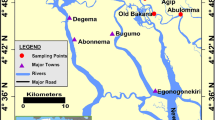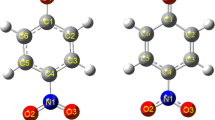Abstract
The changes in the acute toxicity of 16 phenols toward Selenastrum capricornutum and Daphnia magna were examined as a function of their physical/chemical properties. The results demonstrated that phenols with a higher octanol-water partition coefficient (Kow) had a higher toxicity toward aquatic organisms. The toxicity of phenols was closely related to the log Kow values, with correlation coefficients of 0.93 (except for the nitrophenols) and 0.89 for S. capricornutum and D. magna, respectively. The changes in the phenols toxicities in the site waters (i.e., stream and effluent waters) were investigated by calculating the water effect ratios (WER) from the results of the toxicity tests in the site waters using D. magna. The results showed that the degree of ionization for each phenolic compound was altered by the differences in the dissociation constant (pKa), and the change in the toxicity could be predicted. Therefore, the WER should be considered when the toxicity of phenolic compounds is estimated in site waters. The quantitative structure-activity relationships (QSAR) study showed that the toxicity of the phenols to D. magna could be predicted by the hydrophobicity (log Kow) alone and by combining the log Kow with pKa, while the toxicity to S. capricornutum was predicted by a combination of hydrophobicity (log Kow) and ELUMO (or pKa).



Similar content being viewed by others
References
American Public Health Association (APHA) (1989) Standard methods for the examination of water and wastewater, 17th ed. APHA, Washington, DC
Aptula AO, Netzeva TI, Valkova IV, Cronin MTD, Schultz TW, Kuhne R, Schuurmann G (2002) Multivariate discrimination between modes of toxic action of phenols. Quant Struct-Act Relat 21:12–22
Bearden AP, Schultz TW (1997) Structure-activity relationships for Pimephales and Tetrahymena: A mechanism of action approach. Environ Toxicol.Chem 16:1311–1317
Bradbury SP, Russom CL, Ankley GT, Shultz TW, Walker JD (2003) Overview of data and conceptual approaches for derivation of quantitative structure-activity relationships for ecotoxicological effects of organic chemicals. Environ Toxicol Chem 22:1789–1798
Brung WA, Holderman TS, Southerlan MT (1992) Synopsis of water-effect ratios for heavy metals as derived for site-specific water quality criteria. EPA Contract 68-CO-0070, U.S. EPA, Washington, DC
Choi SH, Gu MB (2001) Phenolic toxicity-detection and classification through the use of a recombinant bioluminescent Escherichia coli. Environ Toxicol Chem 20:248–255
Cronin MTD, Schultz TW (1996) Structure-toxicity relationships for phenols to Tetrahymena pyriformis. Chemosphere 32:1453–1468
Cronin MTD, Manga N, Seward JR, Sinks GD, Schultz TW (2001) Parameterization of electrophilicity for the prediction of the toxicity of aromatic compounds. Chem Res Toxicol 14:1498–1505
Cronin MTD, Aptula AO, Dufy JC, Netzeva TI, Rowe PH, Valkova IV, Schultz TW (2002) Comparative assessment of methods to develop QSARs for the prediction of the toxicity of phenols to Tetrahymena pyriformis. Chemosphere 49:1201–1221
Finney DJ (1971) Probit analysis. Cambridge University Press, New York, NY
Eyanoer HF, Upatham ES, Duangsawasdi M, Tridech S (1985) Effect of water hardness and temperature on the toxicity of detergents to the freshwater fish Puntius gonionotus. J Sci Soc Thail 11:67–78
Hanstein WG (1976) Uncoupling of oxidative phosphorylation. Trends Biochem Sci 1:65–67
Howard PH, Meylan WM (1997) Handbook of Physical Properties of Organic Chemicals. CRC Press, Inc, Boca Raton, FL
Jarvinen AW, Ankley GT (1999) Linkage of effects to tissue residues: Development of a comprehensive database for aquatic organisms exposed to inorganic and organic chemicals. Setac Press, Pensacola, FL
Jop KM, Askew AM, Foster RB (1995) Development of a water-effect ratio for copper, cadmium, and lead for the Great Works River in Maine using Ceriodaphnia dubia and Salvelinus fontinalis. Bull Environ Contam Toxicol 54:29–35
McKim JM, Erickson RJ (1991) Environmental impacts on the physiological mechanisms controlling senobiotic transfer across fish gills. Physiol Zool 64:39–67
McLaughlin SGA, Digler J (1980) Transport of protons across membranes by weak acids. Physiol Rev 60:825–863
Russom CL, Bradbury SP, Broderius SJ, Hammermeister DE, Drummond RA (1997) Predicting modes of toxic action from chemicals structure: Acute toxicity in the fathead minnow (Pimephales promelas). Environ Toxicol Chem 16:948–967
Saarikoski J, Viluksela M (1981) Influence of pH on the toxicity of substituted phenols to fish. Arch Environ Contam Toxicol 10:747–753
Smith PD, Brockway DL, Stancil FEJr (1987) Effect of hardness, alkalinity and pH on the toxicity of pentachlorophenol to Selenastrum capricornutum. Environ Toxicol Chem 6:891–900
Terada H (1981) The interaction of highly acute uncouplers with mitochondria. Biochim Biophys Acta 639:225–242
US EPA (1993) Method for measuring the acute toxicity of effluents and receiving waters to freshwater and marine organism, EPA/600/4-90/027F. Environmental Monitoring Systems Laboratory, Cincinnati, OH
Van Leeuween CJ, Hermens JLM (1995) Risk assessment of chemicals: an introduction. Kluwer Academic Publishers, Boston, MA, pp 245–248
Acknowledgments
This work was supported by a grant (code no. 4-1-1) from the Sustainable Water Resources Research Center of the 21st Century Frontier Research Program and by the Ministry of Environment as “The Eco-Technopia 21 Project.”
Author information
Authors and Affiliations
Corresponding author
Rights and permissions
About this article
Cite this article
Lee, Y.G., Hwang, S.H. & Kim, S.D. Predicting the Toxicity of Substituted Phenols to Aquatic Species and Its Changes in the Stream and Effluent Waters. Arch Environ Contam Toxicol 50, 213–219 (2006). https://doi.org/10.1007/s00244-004-1259-6
Received:
Accepted:
Published:
Issue Date:
DOI: https://doi.org/10.1007/s00244-004-1259-6




